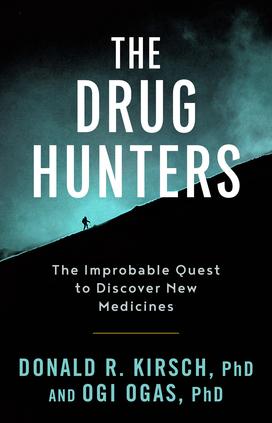‘Drug Hunters’ Brings Narrative to Humankind’s Quest for Medicines

In Drug Hunters: The Improbable Quest to Discover New Medicines (Arcade), Donald Kirsch *78, a drug hunter with 35 years’ experience, brings a colorful narrative to the history of man’s search for new remedies.
The author: Donald Kirsch *78 is a bio/pharmaceutical industry consultant with extensive experience with industrial research, including stints at Bristol-Myers Squibb, Cyanamid Lederle, American Home Products, and Genetics Institute/Wyeth. He was most recently the chief scientific officer at a Kendall Square biotech startup, Cambria Pharmaceuticals. He served an instructor in the pharmacology department of Robert Wood Johnson Medical School, is the author of more than 50 scientific research papers and review articles, and is an inventor on 25 patents and patent applications. Kirsch teaches drug discovery at the Harvard Extension School.
Opening Paragraphs: In the deep mists of prehistory, everybody was a drug hunter. Our parasite-infested, malady-ridden ancestors chewed every new root and leaf they chanced upon, hoping to unleash some fortuitous benefit that might ameliorate their afflictions—and praying they did not perish from their blind experimentation. Through sheer serendipity, some fortunate Neolithic souls stumbled upon substances with medicinal properties, including opium, alcohol, snakeroot, juniper, frankincense, cumin, and—apparently—birch fungus.
Sometime around the year 3300 BC, a solitary man, cold, ill, and mortally wounded, struggled through the high peaks of the Ötztal Alps in Italy until he collapsed in a crevasse. Here he lay frozen for more than five thousand years until hikers stumbled upon his ice-mummified corpse in 1991. The dubbed him Ötzi. When Austrian scientists thawed out this Ice Age hunter, they discovered his intestines had been invested with whipworms. At first the researchers remarked that Ötzi and his contemporaries most likely suffered the indignities of this painful parasite without any hope for relief. A second discovery prompted them to revise their convictions.
Attached to Ötzi’s bearskin leggings were two hide strips, each knotted around a rubbery white lump. These strange bulbs turned out to be fruiting bodies of the birch polypore, a fungus with antibiotic and anti-hemorrhaging properties. It also contained oils that are toxic to whipworms. Ötzi’s hide-knotted mushrooms are quite likely the oldest medicine kit ever found. The Iceman’s medicines did not have high potency or efficacy—but they worked. The existence of a five-thousand-year-old anti-worm drug (what pharmacists would call an antihelminthic) reminds me of something my Ph.D. advisor used to say: “When you see a dog walking on its hind legs, you are not impressed by his grace or agility but rather by the fact he can do it at all.”
Ötzi’s remarkable birch fungus embodies a simple truth about humankind’s quest for medicine. This Neolithic remedy did not arise from clever innovation or rational inquiry. No Stone Age Steve Jobs engineered this antihelminthic out of the visionary workings of his mind. No, Ötzi’s drug was the product of sheer unadulterated luck. All prescientific drug hunting advanced through simple trial and error.
Reviews: “This lucid, anecdote-rich book covers familiar ground for specialists but offers a bright overview for the rest of us of humankind's hunt for medicines. … Kirsch tells the fascinating stories of historic drug discoveries over the centuries. … Highly informative.” — Kirkus
“A lively and sweeping look at the history of drug discovery and how difficult, expensive, and pivotal the search has proven to be. It’s an enlightening, if ominous, survey.” —Publishers Weekly












No responses yet